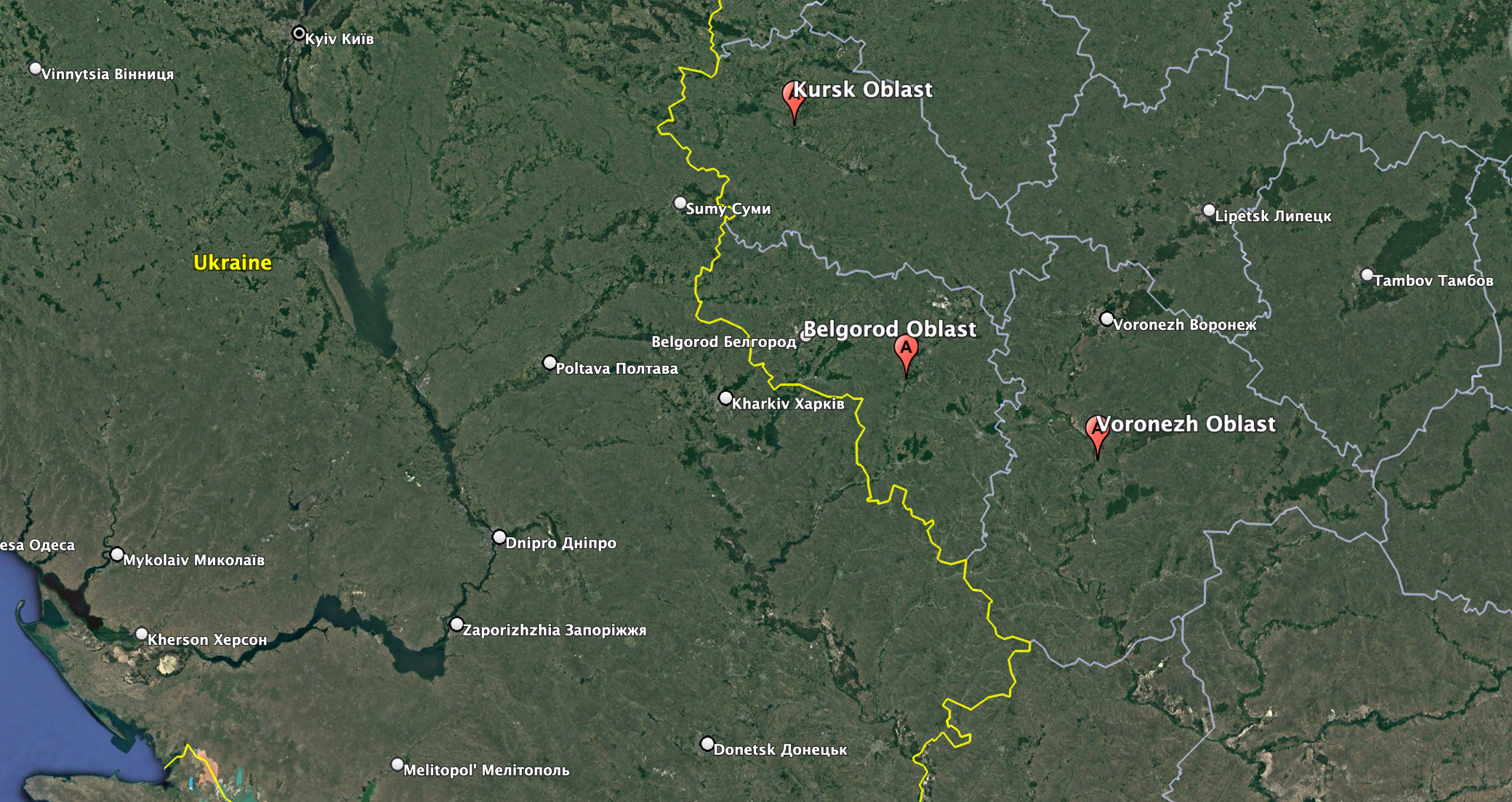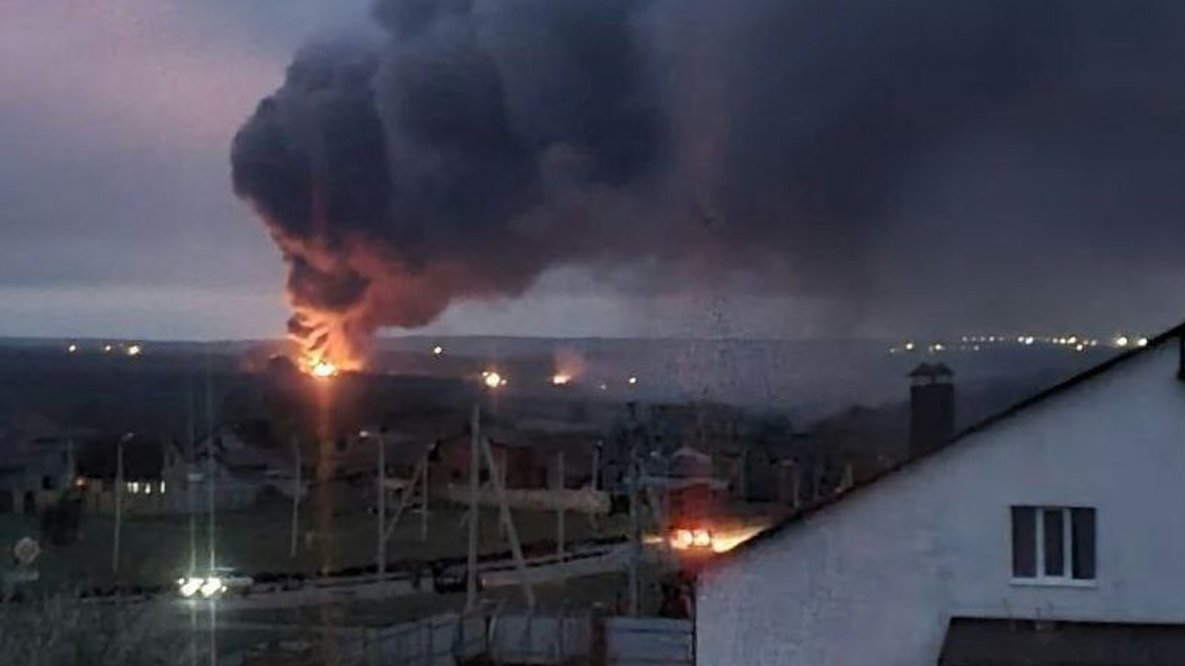Multiple reports state at least three blasts occurred in different Russian provinces along the Ukrainian border early this morning, with an airbase and an ammunition storage site among those affected. While the cause of the explosions is currently unclear, there has been speculation that the incidents reflect a new Ukrainian campaign targeting war-critical infrastructure within Russia itself, which, if true, would represent a significant new development in the conflict.
The three reported blasts were in the Oblasts, or regions, of Belgorod, Kursk, and Voronezh, all of which are adjacent to Ukraine’s eastern border with Russia. The information was reported by local officials as well as the Russian state-run press agency TASS, while multiple accounts and imagery have appeared on social media, too.

In Belgorod, the apparent explosion was at an ammunition depot near the village of Staraya Nelidovka. Local reports suggest that firefighters were deployed to tackle the blaze, which is now extinguished. Vyacheslav Gladkov, the local governor, said on Telegram: “At approximately 03:35 I woke up from a loud bang that sounded like a blast. As I was writing this post, three more blasts were heard.”
In Kursk, unconfirmed reports suggest that Russian air defenses had brought down at least one drone over or near the city of the same name, although the origin of the unmanned aerial vehicle(s) cannot be substantiated. Locals also said they heard military aircraft over Oboyan, in the south of Kursk Oblast, although it’s unclear what aircraft types were involved.
In the Voronezh region, too, there are claims that Russian air defenses were in action, apparently to fend off an attack on Baltimor Air Base, which is home to two squadrons of Russian Aerospace Forces (VKS) Su-34 Fullback strike fighters, roughly 24 in all. The Su-34 is a type that has been employed extensively by Russia in an air-to-ground role over Ukraine.
So far, there have been no reports of civilian or military casualties in any of the three incidents.
At this point, it must be stressed that there is no hard evidence that the incidents were the result of Ukrainian activity, whether launched from Ukraine itself or by operatives that infiltrated Russian territory. There has been no official word from Ukrainian authorities about the possible causes of the blasts, which may, of course, be unrelated. Still, a very suspicious pattern is emerging.
However, Ukrainian presidential adviser Mykhailo Podolyak did say that “the disarmament of the Belgorod and Voronezh killers’ warehouses is an absolutely natural process.”
“If you decide to massively attack another country, massively kill everyone there, massively crush peaceful people with tanks, and use warehouses in your regions to enable the killings, then sooner or later the debts will have to be repaid,” Podolyak said, adding that “Karma is a cruel thing.”
There are photos showing the wreckage of TB2 drones, the preeminent unmanned aerial vehicle type in Ukrainian service, alleged to have been taken in both the Belgorod and Kursk regions. However, it’s possible that these drones could have strayed across the border before being shot down, or crashing, and their presence in these areas alone does not amount to proof that they were responsible for one or more of the blasts. There is also the possibility that these photos actually originate from within Ukraine. Notably, at least one of the TB2s was carrying MAM-series lightweight munitions.
Meanwhile, there is at least speculation that Ukraine may have been behind this morning’s reported blasts, following incidents earlier this week at two major oil facilities in Bryansk. Here, again, the finger of suspicion has been pointed toward Kyiv, with local reports stating that the facilities were triggered by explosions, although also without firm evidence one way or the other. Clearly, the oil facilities are of military significance, to fuel Russia’s continuing campaign in Ukraine, where Moscow’s troops are embarking on a new offensive focusing on the east of the country.
Among the possibilities that have been raised are an airstrike or missile strike on the Bryansk facilities. The latter, potentially, could have involved a Ukrainian Tochka (SS-21 Scarab) tactical ballistic missile, which has a range of up to around 75 miles, which could put the facilities just within reach. An airstrike against Bryansk, by contrast, would represent a very high-risk option, exposing one or more Ukrainian aircraft to extensive Russian air defenses as well as being a significant escalatory move in the context of the wider conflict.
There has been an apparent spate of recent fires at various strategic locations elsewhere in Russia. These include a secretive defense research site in Tver, around 120 miles northwest of Moscow, which you can read more about here, as well as the country’s largest chemical plant, the Dmitrievsky facility in Kinsehma around 250 miles northeast of the capital. The plant reportedly supplies propellants required for precision-guided missiles of the types Russia has been using in the war.
A third fire then broke out in a sensitive facility belonging to the College of Aerospace Engineering and Technology in the Moscow suburb of Korolyov, a major center for Russian space and rocketry programs.
With tensions heightened by the conflict in Ukraine and the fear of possible sabotage by Ukrainian agents, it’s perhaps not surprising that there have been suspicions that Ukraine could be behind these incidents, too. However, there is so far no evidence that the fires in Tver, Kinsehma, and Korolyov were not simple accidents. Indeed, preliminary investigations at the Tver facility suggested faulty wiring may have been the cause. The latest official account of the blaze there provides a death toll of at least 17.
Elsewhere, there have been reports of explosions and fires in recent days in Transnistria, a Russian-backed separatist region of Moldova, to the southwest of Ukraine. Although also unexplained, these have prompted fears that the conflict could spill over into Moldova, too, with Moldovan authorities claiming Russian troops were responsible for a false-flag operation and Transnistrian officials, in turn, blaming Ukraine.
At the very start of the conflict, on February 24, unconfirmed reports emerged that Ukraine has launched a strike against Russia’s Millerovo Air Base less than 20 miles from the Ukrainian border.
Video provided as evidence of a possible attack showed the tail of a VKS Su-30SM multirole fighter amid the flames.
Differing claims suggested that a Ukrainian or possibly a TB2 drone had been used in the strike. There is no confirmation of either of those having been used, however, and it’s equally conceivable that the apparent damage at the base was the result of an accidental fire or some other kind of non-combat-related mishap.
On April 1, reports emerged that a pair of Ukrainian Mi-24 Hind attack helicopters had crossed low over the border into Russia and struck an oil storage facility in Belgorod. If true, that would have been the first strike launched by manned aircraft against Russian territory since at least the Korean War, although, once again, there is no conclusive proof that this was indeed a daring Ukrainian air raid.
Video evidence showed a major conflagration at the oil storage facility as well as a pair of Mi-24s flying under cover of darkness, apparently nearby. However, these could also have been Russian Mi-24s and there remains the possibility that these helicopters attacked the wrong target or were involved in some kind of false flag operation.
For its part, the Ukrainian Ministry of Defense declined to comment directly on allegations that its forces were involved in the Belgorod incident, one official stating that the Ukrainian Armed Forces could not be held responsible for “every catastrophe on Russia’s territory.”
Interestingly, there has been some official support for the idea of Ukraine taking the war beyond its borders and striking back at Russia on its own territory. Yesterday, James Heappey, a British junior defense minister, said that Ukraine would be justified in attacking targets inside Russia to defend itself.
“It’s completely legitimate for Ukraine to be targeting in Russia’s depth in order to disrupt the logistics that, if they weren’t disrupted, would directly contribute to death and carnage on Ukrainian soil,” he told Times Radio.
At the same time, the Russian Ministry of Defense Ministry has threatened to hit back at “decision-making centers” in Kyiv if Ukraine attacks facilities in Russia. The ministry also criticized Heappey’s statement as a “direct provocation” that could “immediately lead to a proportionate response from us.”
As it stands, the lack of firm evidence and resulting confusion surrounding the various incidents on Russian soil plays squarely into the hands of the Ukrainians. Whether Kyiv was involved in some or all of these episodes is, right now, a matter of conjecture, which will only increase concerns among the Russian populace that Ukraine might indeed be waging some kind of covert warfare within Russia’s borders. It would also point to significant gaps in Russia’s ability to defend itself against attack, whether airstrike or missile attacks from the air or covert operations on the ground. At the same time, for Ukraine, these incidents also carry significant propaganda and morale-boosting value, regardless of whether Kyiv is involved in them or not.
And, even if it could be proven that Ukraine was not involved in any of the incidents, that would point to an alarming level of disregard for safety within the various Russian civilian and military authorities responsible for the protection and upkeep of these facilities.
In the conflict so far, fighting has been restricted to areas within Ukraine’s borders. If one or more of these explosions or fires is indeed the result of Ukrainian actions, it would represent a significant widening of the parameters of this war.
Update, 4:30 pm PST: James Heappey, the British armed forces minister, has expanded upon his statement regarding the legitimacy of potential Ukrainian military actions carried out in Russian territory, describing such strikes as “not necessarily a problem,” even if Ukraine were to carry them out using British-supplied weapons.
“In war, Ukraine needs to strike into its opponent’s depth to attack its logistics lines, its fuel supplies, its ammunition depots, and that’s part of it,” Heappey said, adding that it was “completely legitimate” for Ukraine to target objectives in Russia “in order to disrupt the logistics that if they weren’t disrupted would directly contribute to death and carnage on Ukrainian soil.”
It’s not immediately clear which, if any, U.K.-supplied weapons would be applicable to launching potential strikes against targets within Russia, at least from Ukrainian territory. So far, according to official sources, the United Kingdom has donated to Ukraine more than 5,000 anti-tank missiles, five air defense systems with more than 100 missiles, 1,360 anti-structure munitions, and 4.5 tonnes of plastic explosives. However, the United Kingdom has also declared its plan to deliver “high-tech loitering munitions for precision strikes,” although the particular type of weapons involved, and their delivery status, are unclear at present.
Contact the author: thomas@thedrive.com
